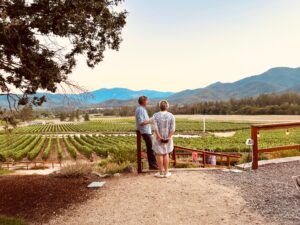Our region is sometimes referred to as “Napa North”. How similar are we?

Could our boutique-style wine country become more Napa-like in the future? Photo taken on the terrace of Vista 222 in The Applegate Valley
by Christina Ammon (Footloose in The Applegate)
I’ve heard the Rogue Valley referred to as “the Next Napa,” or “Napa North” more than a few times. On the surface, the similarities are there: Like in Napa, we have a dry, Mediterranean climate. We also have enough wineries in close proximity to qualify as “wine country” (and some of our tasting rooms are pretty Napa-style upscale!). And our region is increasingly producing wines that fetch awards and catch the attention of big name publications like the New York Times and Sunset Magazine.
Steve Grande, the winemaker for Wooldridge Creek Wineryin the Applegate Valley, understands the comparison. He agrees with it—to a certain extent.
“I think when people make that comparison, they are harkening back to the past,” he explains. “The spirit you saw in Napa in the 1970s is very much alive here: The idea that if any of us succeed, we’re all succeeding. We are in a phase where we have a ton of collaboration, and folks are discovering how exciting this area can be.”
Key Differences…
But Grande, along with several other Applegate winegrowers, points out the significant differences between us and that iconic wine region to our south. The major one being the scale of everything, starting with the population.
“It’s not possible for us to be the next Napa,” says Craig Camp, General Manager of Troon Vineyards. “There is no major urban center.” The numbers tell the story: While there are approximately 220,000 people in the Rogue Valley, there are over three million in the San Francisco metro area. This makes a big difference in the volume of wine tourism.
There is also a massive difference in wine production. For comparison: There are 40,000+ acres of vineyards in Napa, and only 4,000 in the Rogue Valley (750 of those are in the Applegate). And while Napa has 400 wineries, the Rogue Valley has around 50.
Mark Wisnovsky, owner of Valley View Winery, explains that it’s difficult for our local wineries to “scale up” because of the nature of our landscape. “Napa is more contiguous. If someone wanted to plant 100-200 acres here—which in the wine world is not very big—it would be a challenge to find that much contiguous land.”
There are also many different types of activities that draw people to the Applegate.” We don’t get just the pure wine tourist that you get more of in Napa,” Wisnovsky explains. Reasons for that include a lack of lodging and restaurants to complete the wine country experience. This is partly due to Oregon land-use laws that limit commercial zoning in rural areas.
A more rural, authentic experience…
While Napa’s success has mythic and admirable proportions, most local winemakers are glad that the likeness is limited. For one, our small wineries don’t face the same commercial pressures of Napa wineries. This liberates winegrowers to experiment with different techniques and varieties. In Napa, high land prices put winemakers under pressure to produce surefire, blockbuster wines–mostly cabernets– that will pay the bills.
Mike Brunson, Valley View’s winemaker, has worked in these larger regions and enjoys the Applegate’s smaller scale. “The Applegate has a European feel,” he says. “People are doing their own thing. It’s nice working with and for people who believe in representing a place.”
Could our boutique-style wine country become more Napa-like in the future? Joe Ginet, the owner of Plaisance Ranch, hopes not. “There is not enough total wine being produced down here to turn a corporate eye,” he says. He’s glad about that– though worries that relatively cheap land prices could make it attractive. “I moved here because it is NOT Napa.”
That feeling is shared by Grande. “Nobody wants to see Mondavi set foot down here.”
Craig Camp bets wine country tourists feel the same way. “People are burned out on commercialization,” he says, “They are looking for a more rural, authentic experience.”


